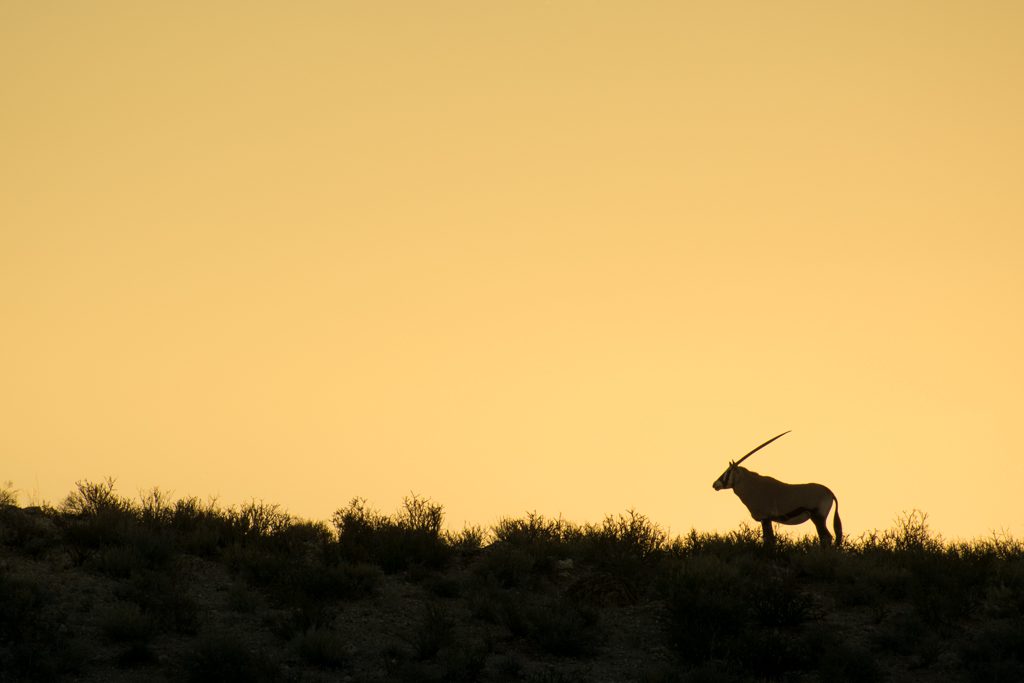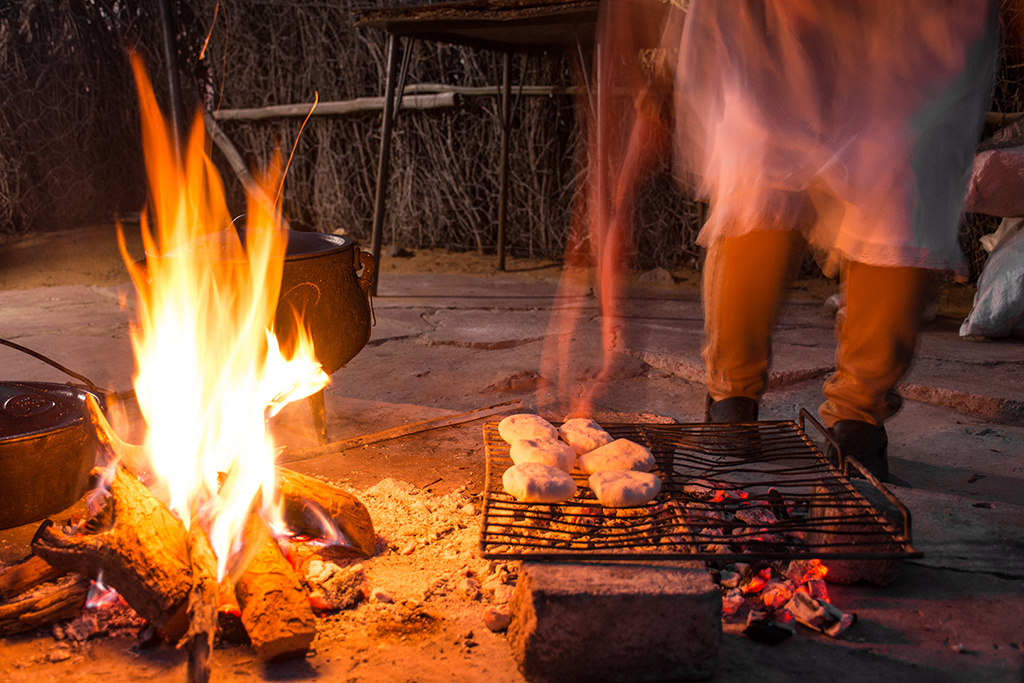The declaration of the ǂKhomani Cultural Landscape as a World Heritage site marks a significant progress for the ǂKhomani San, who are also known as ‘the first people’.

Sunset at the Erin Game Range. Photo by Melanie Van Zyl.
The ǂKhomani Cultural Landscape has been declared a World Heritage Site by UNESCO, the declaration means South Africa has a total of nine World Heritage Site destinations.
The ǂKhomani Cultural Landscape was the only new South African destination declared a World Heritage site in 2017 (out of 25 new sites worldwide) and is a milestone for the Khomani San. Their ownership of the Kgalagadi Transfrontier Park made their case the most current successful example of aboriginal land claim in Southern Africa. The claim of the 65000-hectare land was settled out of court by the then newly appointed South African government.

A walk through the traditions of the Khomani San. Image by Melanie van Zyl
The cultural landscape bears testimony to a way of life that prevailed in the harsh desert conditions of this region. The Khomani San have played a pivotal role in the preservation of South African heritage with evidence dating as far back as the Stone Age.
“The large expanse of sand contains evidence of human occupation from the Stone Age to the present and is associated with the culture of the formerly nomadic ǂKhomani San people and the strategies that allowed them to adapt to harsh desert conditions,” notes UNESCO. The landscape is characterised by a unique biosphere with red sand dunes throughout the region.
The San are traditional hunter-gatherers who inhabited the Kalahari desert between South Africa, Botswana and Namibia. About 1500 adults are said to be spread out throughout various towns of the Northern Cape. After losing their rights to hunt and manage stock, they were forcibly removed from the land under a 1930s settlement.

The Bushmen struggle to keep their traditions and way of living alive in the Kalahari, but there are still some people that fight for their community. ‘Together we are stronger’, Barbara said to me, holding her grand-uncle. Image by Yann Macherez.
The case for the land claim was assisted by Human Rights Lawyer, Roger Chennells. Roger met Dawid Kruiper, one of the prominent elders in the community, in 1992. Impressed by Dawid Kruiper, his family and the hospitality, Roger wanted to help Dawid and his community get back their ancestral land. Given the politically volatile climate in the country at the time, Roger thought it was the perfect timing to assist the community get back their land.
The land claim agreement signed in 1999 granted the Khomani San tourism rights over 80000 hectares inside the Kgalagadi National Park. They were also given the rights to use a portion of the park for cultural purposes. Cultural purposes include hunting, walking and engaging with the land as they used to for many years before they were forcibly removed.
The cultural landscape might have a long way to go with resources to make it a state-of-the-art park but one cannot deny the impact of this landscape on the South African heritage. It contributes hugely to South African history and ensures the survival of ‘the first people’ on earth.
Visit the Khomani San Landscape
Those who visit the landscape can expect guided day trips, tented bush camps and cultural experiences for groups or visitors run by Khomani San. The Khoman San community is steadily using their land to gain financial independence, as such, you will find locals who delight in sharing knowledge about their heritage. This is encouraging because it means that the community can directly benefit from tourism developments in the area. Developments that will not jeopardise nature and the land of their ancestry.

A Gemsbok stands majestically on a calcrete ridge at sunset in the Kgalagadi. Photo by Melanie van Zyl
The preservation of their land – which means using it for tourism purposes – does mean a certain level of integration into urban society. Dirk Vilander, who grew up in the land is now a qualified guide, teaching people about the heritage of the land took us on a game drive through the Erin Game Ranch where we saw plenty of animals like springbok, zebra, wildebeest and jackals.
I asked him about the possible clash between the younger generation that’s assumably modern, like him, and the elders whom one imagines would be cautious of developments. The middle ground between tradition and allowing room for tourism development, he says, is the key to preserving this land. Tourism developments in the are mean that people get the opportunity to enjoy what the San have enjoyed for thousands of years – a relationship with nature. Preserving the land for tourism prevents industrial developments like mining, which the elders are against, he adds.

Aunt Koera preparing dinner at the Erin Game Farm. Photo by Melanie Van Zyl.
The land is currently being used for various community-led initiatives, like Aunt Koera’s kitchen, camping in the Kalahari and special heritage tours.
I visited Aunt Koera’s Kitchen and enjoyed a homemade dinner while learning a lot about her heritage. Upon arrival, I found her rolling and cutting up the dough for fresh roosterkoek which was to be served alongside lamb stew with sweet carrots. The salad is made using the wild and tangy ‘gemsbok cucumbers’ grown in the Kalahari desert. Cooking was always Aunt Koera’s passion and she uses a portion of the communal land on Erin Game Ranch to feed travellers. All her meals are cooked over the fire because it keeps with the traditions of Kalahari cuisine.
Plan your trip
To visit Aunt Koera’s Farm Kitchen, call her on 0835888346 for bookings. Or visit openafrica.org
To sleep nearby, try Boesmansrun Grass Huts, which is also a community-run initiative. The huts are authentic, rustic grass huts with basic facilities. Good if you’re just looking for a bed to lay your head down overnight. Call 0783280578 or visit openafrica.org
Read more about the Khomani San, camping facilities and other acitivities at khomanisan.com
Welcome visited the Komani Landscape for the August 2017 issue of Getaway magazine.
Get this issue →
Our August issue features 14 Northern Cape treasures, a trip along Mozambique’s pristine beaches on a fat-bike, holidays to take if you want to learn a new skill and so much more.
You may also like
Related Posts
The Northern Cape landscape and its characters are full of life. Here are some of...
read more
If you're feeling a bit tired of the usual scene, take a tip from urban...
read more
The east coast is our very own tropical paradise with warm waters and laid-back vibes....
read more